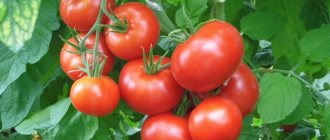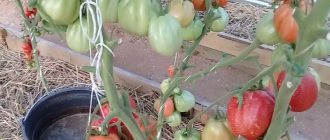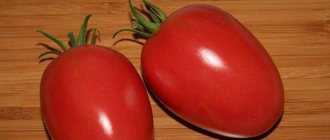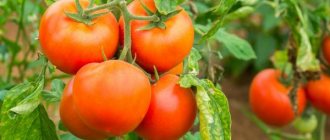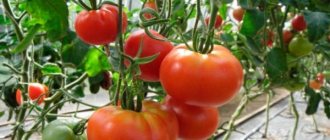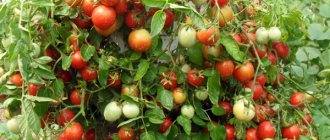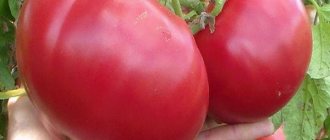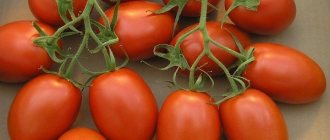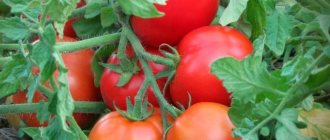Our production
Dyno tomatoes
Dino tomatoes are medium-early ripening tomatoes that the Yaroslav-Agro Peasant (farm) enterprise has been growing not long ago.
But during such a short acquaintance, Dino impressed us: with his resistance to diseases, high productivity, and excellent commercial qualities of simultaneously ripening fruits. And we understood why farmers in Poland, Ukraine and Russia loved this variety so much. Dino feels great both in a greenhouse and in open ground, which we tested from our own experience. Despite their compactness, tomato leaves do a good job of protecting ripening tomatoes from sunburn.
The Dino tomato plant is determinate, which translated from Latin means “having a limit” to growth. After tying 4-8 tassels, the bush stops growing. This happens when it reaches a height of approximately 1.1 m. Thanks to this characteristic of the hybrid, we spend less time and effort on tying up the bushes, and more on caring for them: hand weeding, regular watering with artesian water, and manual picking of tomatoes.
Dyno tomatoes in the greenhouse of the Yaroslav-Agro peasant farm
Dino's fruits are large and medium in size, uniform on the bush and have the same plum-like shape. The length of the tomato reaches 8 cm with a waist size of 5.5 cm. The weight of one tomato ranges from 130 to 150 g. The skin is smooth, glossy, and uniformly bright red in color. Biological maturity in tomatoes, that is, complete ripening of the seeds, occurs earlier than technical maturity, when the fruits can be eaten. Therefore, we harvest tomatoes at the stage of technical ripeness, when they turn completely red. Not out of shame. That's for sure!
Harvesting dates for Dyno tomatoes at the Yaroslav-Agro farm
We harvest our first Dino harvest in mid-June. The season lasts until the end of July. During this time, you can buy and enjoy fresh, vitamin-packed, organic Dino tomatoes.
Origin
Dino tomatoes are a first generation hybrid created by a French company specializing in the selection of professional seeds for vegetable producers. The variety was registered in 2015 under the trademark Clause.
Taste qualities
The range of expert reviews about the taste of Dino tomatoes ranges from excellent to excellent.
The Dino variety of tomato is dense, strong, and fleshy. Inside there are three small chambers for seeds. The taste of the tomato is sweet and sour, but without the characteristic tomato aroma. The pulp is tender, homogeneous, juicy. The same bright red color as the skin.
The dry matter content, according to the originator, that is, the creator of the hybrid, is 5.2 - 5.6%.
Storage
Dino tomatoes are characterized by keeping quality, that is, they are stored for a long time and at the same time retain their consumer properties.
Before storing fresh tomatoes, carefully sort them out and set aside any spoiled or bruised ones.
Important! Tomatoes should only be washed before use, otherwise they will begin to rot.
Important! Tomatoes with sepals and stalks (tails) are stored better and longer.
At room temperature not exceeding 20 degrees Celsius, Dino tomatoes will last up to 14 days.
To do this, carefully place the tomatoes, tails up, into a basket or box with side holes for ventilation, cover the top with a clean kitchen towel or cotton napkin and place in a dark, well-ventilated place.
In the refrigerator, Dino tomatoes will last up to 1 month without loss of elasticity and juiciness.
The optimal storage temperature for tomatoes in the refrigerator is not lower than 7 degrees. It is better to store tomatoes in perforated bags. In their absence, you can line an enamel pan with a clean, dry kitchen towel, place freshly sorted tomatoes in it, cover the top with a cotton or linen napkin and put this structure in the refrigerator.
Transportation
Dino variety tomatoes, due to their density and fleshiness, are transportable and perfectly tolerate long-distance transportation while maintaining their presentation and consumer qualities.
Dense and elastic tomatoes do not deform during transportation. Losses are minimal.
Transportation of Dino tomatoes requires a refrigeration chamber with forced air cooling. The optimal temperature is 7-20 degrees Celsius with a relative humidity of 90-95%. Subject to temperature and humidity conditions, Dino tomatoes will retain excellent presentation for up to 14 days.
The best containers for transporting Dino tomatoes are wooden, cardboard or polymer boxes.
Use in cooking
The Dino tomato variety is intended for industrial processing: for the production of juices, pastes, and purees.
In general, Dino is universal. High ratings of its taste speak in favor of its fresh consumption.
The dense, fleshy pulp makes Dino indispensable for use in vitamin preparations for the winter. Lecho, ketchups, adjikas, pastes and sauces are made from Dino tomatoes.
Description of tomato Dino F1, cultivation and reviews from gardeners
Summer residents are interested in how to grow the Dino F1 tomato, reviews of which they saw on websites on the Internet. This variety recently appeared on the Russian market and is grown both by ordinary amateur gardeners and by industrial companies engaged in the cultivation of vegetable crops. In such a short period of time, Dino managed to strengthen his position in the market.
Firstly, due to its resistance to a number of diseases common among tomatoes. Secondly, due to good yield indicators. Thirdly, because it has all the qualities of a good product that make it possible to successfully sell the finished product on the market. That is why Dino is now so widespread in all regions of Russia.
How to grow Dino tomato?
This variety can be grown not only in greenhouse conditions, but also in open spaces. Due to their compact size, the bushes do not require special care, and the leaves of the plants are able to reliably protect ripening fruits from the scorching sun and other unfavorable climate conditions.
The plant is determinate, that is, it grows upward to the appropriate limit, as a rule, Dino reaches only 1 m in height. About 8 clusters are tied on each stem, after the last one is tied the bush stops growing. All this allows the farmer or gardener not to spend a lot of time and effort tying the bush to a support and shaping it in such a way that it does not fall under the weight of the fruit.
This way, you will have more time to devote to caring for the plant. It needs regular weeding, constant watering with clean water, and harvesting.
Tomatoes are either medium or large in size, depending on the care: the better it is, the larger the fruits. On the bush, the tomatoes look uniform and have a plum-like shape. The length of each fruit can reach 8 cm, with a volume in the center of the fruit of 5.5 cm. 1 tomato can reach a weight of 150 g or slightly less.
The color of the fruit is rich red, the skin is smooth and glossy. It is quite dense, which makes it possible to transport crops over long distances. The fruits must be collected from the bush at the moment when they completely turn red. They can be eaten fresh and added to various dishes.
As a rule, the first harvest becomes possible at the beginning of summer, and the bushes bear their last fruits at the end of the second summer month. It is during this period that it is better to grow or buy Dino tomatoes in order to get the greatest amount of vitamins and nutrients.
- Early maturation. By mid-summer you will have a guaranteed harvest of tasty and juicy tomatoes.
- Easy to care for. Thanks to small bushes, there is no need for staking and pinching of plants. However, you need to be careful about watering and weeding the soil: they directly affect the yield of the plant.
- Strong and reliable skin, which allows you to transport tomatoes over long distances. The fleshy pulp retains its taste for a long time. It is recommended to store tomatoes at a temperature no higher than +20 °C; in such a climate they can remain in one place for about 2 weeks.
Widely used in cooking, can be consumed both fresh and processed. Tomato can also be used for canning for the winter. Excellent taste, thanks to which farmers return to growing this variety of tomatoes again and again.
Reviews from gardeners
Svetlana Egorovna, Cheboksary:
“A couple of years ago, I planted Dino tomatoes in my greenhouse for the first time and read about what needs to be done to make them grow well. She did everything as expected: weeded, watered. As a result, I reaped an excellent harvest. Enjoyed fresh tomatoes for several weeks. And then they used the leftovers for pickling, and in the winter they continued to enjoy the canned fruits. This year I’m trying to plant it in open ground, fortunately the climate allows it. But just in case, I’ll plant a couple of bushes in the greenhouse so as not to be left empty-handed.”
Diseases and pests
Dean's yellow tomatoes often suffer from late blight, blossom end rot, and watery fruit rot. The first disease manifests itself in the appearance of brown spots on the leaves of plants. Later, these spots spread to the fruits, causing them to become deformed and take on an ugly shape. Then the fruit begins to rot and smell unpleasant.
To save plants from late blight, you can use drugs such as Ecosil, Fitosporin, Ridomil Gold MC, Tattoo, Bordeaux mixture and Quadris. With watery rot, the surface of the tomatoes is covered with watery spots, after which the internal tissues of the vegetable begin to rot and turn into a watery substance.
To prevent the development of this disease, it is necessary to remove all plant debris after harvesting, thin out dense plantings and remove affected plants, and also promptly treat the plantings with insecticidal preparations that will prevent the invasion of caterpillars. Blossom rot is expressed by the appearance of dark spots on the tops of the fruit. It darkens and presses in, making the fruit dry and hard. Calcium nitrate and chalk suspension will help save plants from this disease.
Proper care of Dina tomatoes will provide you with a stable harvest of tasty and healthy fruits, the bright sunny color of which will attract the admiring glances of your neighbors in the country. You can use these tomatoes not only for personal consumption, but also for sale.
Tomato Dino - description and characteristics of the variety
Proscinitary of tomato
We must immediately talk about this hybrid, which appeared thanks to the many years of work of French breeders from the Clause company. This representative of tomato crops is resistant to such common diseases as fusarium, bacterial spot. The variety is distinguished by high yield and good taste. These qualities together have led to the fact that the new product has now become widespread, and farmers and ordinary people are eager to purchase the seeds of the hybrid. Ant. summer residents command staff.
Features of the variety
With good care, Dino F1 tomatoes reach impressive sizes. By the time of maturation, seedlings form a branched bushy system with a powerful root system. However, the height of determinate tomato bushes reaches no more than one meter. Thick leaves protect fruits from the harmful effects of sunlight.
The first fruits appear, as a rule, 70 days after planting the seedlings. They have an elongated plum-shaped shape, and their length reaches 8 cm. According to experienced gardeners, more than 4 fruits weighing up to 150 grams can be removed from each cluster. The fruits have a rich, bright red hue. They have a fairly dense skin that gives off a glossy sheen.
If “Dino F1” tomatoes are stored at temperatures up to 20*, they will retain all their qualities for two weeks. Tomatoes of this variety can be added to salads, frozen, and included in various dishes.
Tomato Dino - description and characteristics of the variety
The appearance of a new tomato variety, “Dino F1,” aroused great interest among domestic summer residents. After all, the first practical experiments of ordinary amateur gardeners showed that this new product is superior in quality to many popular varieties. It is also attractive that tomato is successfully cultivated not only in regions with a favorable stable climate, but also in the central regions of Russia and in Belarus. In addition, the Dino f1 tomato feels excellent in garden beds and in the field; this variety also produces high yields in greenhouses.
Description of tomato
Let’s be clear: this is a hybrid that appeared thanks to the many years of work of French breeders from the Clause company. This representative of tomato crops is resistant to such common diseases as: fusarium, bacterial spot. The variety is distinguished by high yield and good taste. All these qualities together have led to the fact that the new product has become widespread today, and farmers and ordinary summer residents are eager to purchase hybrid seeds.
Features of the variety
The first fruits appear, as a rule, 70 days after planting the seedlings. They have an elongated plum-shaped shape, and their length reaches 8 cm. According to experienced gardeners, more than 4 fruits weighing up to 150 grams can be removed from each cluster. The fruits have a rich bright red hue. They have a fairly dense peel that gives off a glossy shine.
If Dino F1 tomatoes are stored at temperatures up to 20*, they will retain all their qualities for two weeks. Tomatoes of this variety can be added to salads, canned, and included in various dishes.
Important point!
Experts recommend not removing tomatoes from the bush until they turn completely red.
Advantages of a hybrid
Of course, the complex of outstanding characteristics of the “Dino F1” variety increases the demand for the purchase of seeds of this crop. Summer residents and farmers who have been cultivating the hybrid for several seasons have drawn their own conclusions regarding its worthy qualities. Here is a list of these benefits:
- Early ripening allows you to get a stable harvest in mid-summer.
- Simple care does not require pinching and staking of plants, which is obligatory for other crops. If tomatoes are regularly watered and weeded, they will enjoy a good harvest.
- A strong skin protects tomatoes from damage and allows them to be transported over long distances.
- Excellent taste will enrich the family's daily diet.
Drop off time
By the way, the hybrid “Dino F1” grows well not only in greenhouse conditions, but also in open ground. The compact parameters of the bushes allow you to plant many plants in small spaces. Since the crop does not require special care, a summer resident or farmer may not waste time on additional activities. Seeds should be sown in mid-March if the crop is grown in an average climate zone. First you need to prepare the soil:
- The soil must be mixed with river sand, peat or humus added.
- The soil must be disinfected by calcination, freezing or steaming.
- The seeds of the hybrid "Dino f1" do not require chemical treatment or germination.
- Plant 2 grains in each peat pot 1.5 cm deep.
- The seeds are sprinkled with earth on top, then the sowing area should be sprinkled with water.
- When the first leaves appear, you need to pick the plant.
Helpful advice!
The seedlings are planted in open soil along with the pot. This procedure should be carried out only after the end of the frost period. In this case, the height of the tomato should be at least 20 cm. Bushes should be planted at a distance of 40 cm.
Rules of care
Reviews from summer residents about the hybrid "Dino F1"
- Svetlana Lazareva, Cheboksary:
I first tried to plant hybrids about five years ago. I tried to do everything according to the instructions to get a good harvest. And indeed, my hopes did not deceive me: all summer my family feasted on fresh tomatoes. It was enough to make supplies for the winter. - Tatiana Igorevna, Moscow region:
Tomato seeds “Dino f1” were given to me by a neighbor in the country. The first harvest simply stunned me, because I am not a fan of gardening. I practically didn’t care for the bushes, but I watered them regularly and pulled out the grass. But the fruits pleased me with their early ripening and amazing taste.
Rules of care
The location of the tomato bed is selected in an area that is well ventilated and illuminated by the sun all day. Tomato bushes are planted at a distance of 40 cm. The soil on which they are located must be loosened after 2 or 3 weeks and the weeds must be weeded, otherwise insect pests will appear and the bushes will begin to thicken.
Hybrids should be watered at the root, making sure that water does not get on the leaves and inflorescences. Tomatoes are moistened once or every 7 days. To ensure that nutrients are used for the formation of fruits, the stepsons are regularly removed.
During the season, tomatoes are fed 4 times with mineral and organic fertilizers, and the bushes must be hilled. Tomatoes are harvested by hand.

